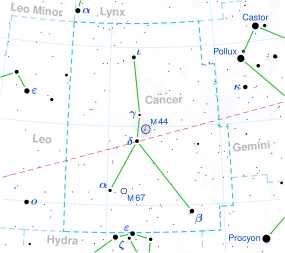| Observation data Epoch J2000 Equinox J2000 | |
|---|---|
| Constellation | Cancer |
| Right ascension | 08h 29m 49.345s[2] |
| Declination | +26° 46′ 33.74″[2] |
| Apparent magnitude (V) | 14.81[3] |
| Characteristics | |
| Spectral type | M6.5V[4] |
| Apparent magnitude (J) | 8.2[3] |
| U−B color index | +2.11[5] |
| B−V color index | +2.08[5] |
| Variable type | Flare star[3] |
| Astrometry | |
| Radial velocity (Rv) | +9.0[6] km/s |
| Proper motion (μ) | RA: −1,140[2] mas/yr Dec.: −602[2] mas/yr |
| Parallax (π) | 279.2496 ± 0.0637 mas[7] |
| Distance | 11.680 ± 0.003 ly (3.5810 ± 0.0008 pc) |
| Absolute magnitude (MV) | 16.98[8] |
| Details | |
| Mass | 0.106±0.009[9] M☉ |
| Radius | 0.1235±0.0006[9] R☉ |
| Luminosity | 0.00073±0.000007[9] L☉ |
| Surface gravity (log g) | ~5[9] cgs |
| Temperature | 2,840[10] K |
| Rotation | 0.46 days[11] |
| Rotational velocity (v sin i) | 11.0[12] km/s |
| Age | 200[13] Myr |
| Other designations | |
| Database references | |
| SIMBAD | data |
Location of DX Cancri in the constellation Cancer | |
DX Cancri is a variable star in the northern zodiac constellation of Cancer. With an apparent visual magnitude of 14.81,[3] it is much too faint to be seen with the naked eye. Visually viewing this star requires a telescope with a minimum aperture of 16 in (41 cm).[14] Based upon parallax measurements, DX Cancri is located at a distance of 11.8 light-years (3.6 parsecs) from Earth. This makes it the 18th closest star (or star system) to the Sun.
The star has a stellar classification of M6.5V,[4] identifying it as a type of main sequence star known as a red dwarf. It has about 10% of the mass of the Sun, and 12% of the Sun's radius.[9] The outer envelope of the star has an effective temperature of 2,840 K,[10] making it an M-type star. It is a flare star that has random, intermittent increases in brightness by up to a factor of five. It is a proposed member of the Castor Moving Group of stars that share a common trajectory through space. This group has an estimated age of 200 million years.[15]
- ^ Cite error: The named reference
Pettersenwas invoked but never defined (see the help page). - ^ a b c d Cite error: The named reference
susnoccdacwas invoked but never defined (see the help page). - ^ a b c d e Cite error: The named reference
simbadwas invoked but never defined (see the help page). - ^ a b Cite error: The named reference
apj659_2_1629was invoked but never defined (see the help page). - ^ a b Cite error: The named reference
aj86was invoked but never defined (see the help page). - ^ Cite error: The named reference
mnras328_1_45was invoked but never defined (see the help page). - ^ Brown, A. G. A.; et al. (Gaia collaboration) (2021). "Gaia Early Data Release 3: Summary of the contents and survey properties". Astronomy & Astrophysics. 649: A1. arXiv:2012.01533. Bibcode:2021A&A...649A...1G. doi:10.1051/0004-6361/202039657. S2CID 227254300. (Erratum: doi:10.1051/0004-6361/202039657e). Gaia EDR3 record for this source at VizieR.
- ^ Cite error: The named reference
reconswas invoked but never defined (see the help page). - ^ a b c d e Cite error: The named reference
carmeneswas invoked but never defined (see the help page). - ^ a b Cite error: The named reference
apj656_2_1121was invoked but never defined (see the help page). - ^ Cite error: The named reference
mnras407_4_2269was invoked but never defined (see the help page). - ^ Cite error: The named reference
apj704_2_975was invoked but never defined (see the help page). - ^ Cite error: The named reference
aaa506_3_1455was invoked but never defined (see the help page). - ^ Cite error: The named reference
sherrod_koed2003was invoked but never defined (see the help page). - ^ Cite error: The named reference
aaa460_3_733was invoked but never defined (see the help page).

